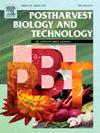CsbHLH6 在采后贮藏期间对脱落酸介导的柑橘果实着色具有正向调节作用
IF 6.4
1区 农林科学
Q1 AGRONOMY
引用次数: 0
摘要
众所周知,柑橘果实采后脱落酸(ABA)处理可通过促进类胡萝卜素的积累而显著提高果实着色,但其潜在的分子机制尚不清楚。在本研究中,我们通过激活采后贮藏过程中 4 个关键类胡萝卜素代谢基因(CsPSY、CsLCYB、CsHYD 和 CsNCED2)的表达,进一步证实了 ABA 处理在促进柑橘果实着色方面的作用。通过酵母单杂交筛选,利用 ABA 诱导的 3 个关键类胡萝卜素代谢基因(CsLCYB、CsHYD 和 CsNCED2)的启动子鉴定出了一种新型碱性螺旋环螺旋(bHLH)转录因子 CsbHLH6。CsbHLH6 的过表达增强了柑橘果实和胼胝体中类胡萝卜素的积累。干扰 CsbHLH6 在柑橘胼胝体和果实中的表达表明,CsbHLH6 对 ABA 诱导的类胡萝卜素生物合成和果实着色至关重要。作为细胞核定位的转录激活因子,CsbHLH6 直接与 6 个关键类胡萝卜素代谢基因(CsPSY、CsLCYB、CsLCYE、CsHYD、CsZEP 和 CsNCED2)的启动子结合,随后激活了它们在体外和体内的表达。此外,ABA 信号明显提高了 CsbHLH6 启动子的活性,从而增强了 CsbHLH6 对类胡萝卜素积累的调控。总之,我们的研究揭示了 CsbHLH6 在采后贮藏期间调控 ABA 诱导的柑橘果实着色的分子机制,这对改善柑橘果实采后外观品质至关重要。本文章由计算机程序翻译,如有差异,请以英文原文为准。
CsbHLH6 positively regulates abscisic acid-mediated citrus fruit coloration during postharvest storage
As is well known, postharvest abscisic acid (ABA) treatment of citrus fruits can significantly enhance fruit coloration by promoting the accumulation of carotenoids, however, the underlying molecular mechanism is still unclear. In this study, we further confirmed the effect of ABA treatment in promoting citrus fruit coloration by activating the expression of 4 key carotenoid metabolism genes (CsPSY, CsLCYB, CsHYD, and CsNCED2) during postharvest storage. A novel basic helix-loop-helix (bHLH) transcription factor, CsbHLH6, was identified using the promoters of 3 key ABA-induced carotenoid metabolism genes (CsLCYB, CsHYD, and CsNCED2) by yeast one-hybrid screening. Overexpression of CsbHLH6 enhanced carotenoid accumulation in citrus fruits and calli. Interference with CsbHLH6 expression in citrus calli and fruits indicated that CsbHLH6 was essential for ABA-induced carotenoid biosynthesis and fruit coloration. As a nucleus-localized transcriptional activator, CsbHLH6 directly bound to the promoters of 6 key carotenoid metabolism genes (CsPSY, CsLCYB, CsLCYE, CsHYD, CsZEP, and CsNCED2), subsequently activating their expression in vitro and in vivo. Furthermore, ABA signaling significantly raised CsbHLH6 promoter activity, thus enhancing the regulation of carotenoid accumulation by CsbHLH6. In summary, our study reveals the molecular mechanism by which CsbHLH6 regulates ABA-induced citrus fruit coloration during postharvest storage, which is crucial for improving the postharvest appearance quality of citrus fruits.
求助全文
通过发布文献求助,成功后即可免费获取论文全文。
去求助
来源期刊

Postharvest Biology and Technology
农林科学-农艺学
CiteScore
12.00
自引率
11.40%
发文量
309
审稿时长
38 days
期刊介绍:
The journal is devoted exclusively to the publication of original papers, review articles and frontiers articles on biological and technological postharvest research. This includes the areas of postharvest storage, treatments and underpinning mechanisms, quality evaluation, packaging, handling and distribution of fresh horticultural crops including fruit, vegetables, flowers and nuts, but excluding grains, seeds and forages.
Papers reporting novel insights from fundamental and interdisciplinary research will be particularly encouraged. These disciplines include systems biology, bioinformatics, entomology, plant physiology, plant pathology, (bio)chemistry, engineering, modelling, and technologies for nondestructive testing.
Manuscripts on fresh food crops that will be further processed after postharvest storage, or on food processes beyond refrigeration, packaging and minimal processing will not be considered.
 求助内容:
求助内容: 应助结果提醒方式:
应助结果提醒方式:


